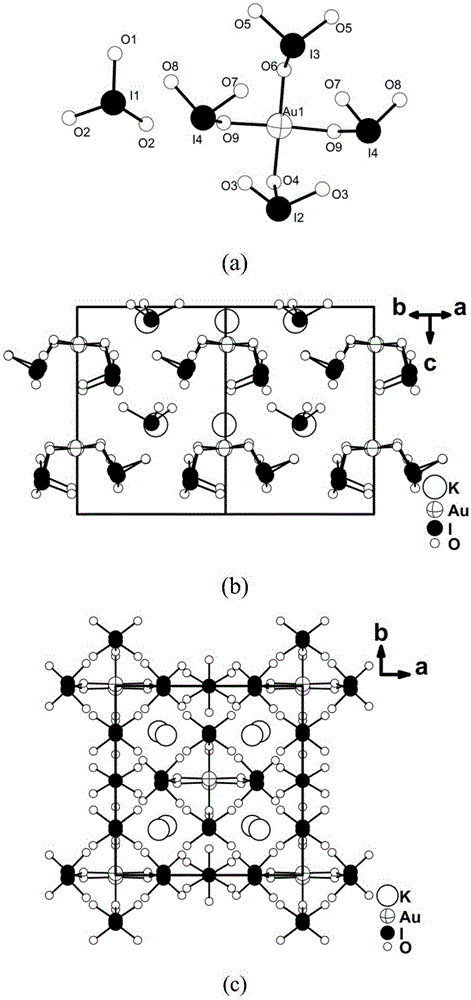Inorganic compound K2Au(IO3)5 with non-heart structure, and preparation method and application thereof
A technology of inorganic compounds and mixtures, applied in chemical instruments and methods, nonlinear optics, optics, etc., to achieve the effect of simple process, high crystallinity, and phase matching
- Summary
- Abstract
- Description
- Claims
- Application Information
AI Technical Summary
Problems solved by technology
Method used
Image
Examples
Embodiment 1
[0039] Embodiment 1 adopts hydrothermal synthesis to synthesize inorganic compound K 2 Au(IO 3 ) 5 the crystal
[0040] The raw material mixture obtained by mixing the raw materials according to a certain ratio is sealed in a 23mL polytetrafluoroethylene-lined hydrothermal reaction kettle, put into a box-type resistance furnace, crystallized at the crystallization temperature for a period of time, and then slowly lowered the temperature. After filtering, washing and drying, a yellow transparent K 2 Au(IO 3 ) 5 crystals. The types of raw materials contained in the raw material mixture, the ratio of each raw material, the crystallization temperature, the relationship between the crystallization time and the sample number are shown in Table 1.
[0041] Table 1K 2 Au(IO 3 ) 5 The relationship between synthesis conditions and sample numbers
[0042]
Embodiment 2
[0043] Embodiment 2 inorganic compound K 2 Au(IO 3 ) 5 Analysis of the crystal structure of
[0044] The structures of samples 1# to 6# were analyzed by single crystal X-ray diffraction and powder X-ray diffraction.
[0045] Wherein, the single crystal X-ray diffraction is carried out on a SuperNovaDualWavelengthCCD type X-ray single crystal diffractometer of Agilent Company. The crystal size is 0.16×0.13×0.09mm 3 ; The data collection temperature is 295K, and the diffraction light source is monochromatic Mo-Kα rays The data were processed with absorption correction using the Multi-Scan method. Structural analysis was completed using the SHELXTL-97 program package; the position of the heavy atom was determined by the direct method, and the coordinates of the remaining atoms were obtained by the difference Fourier synthesis method; 2 The full-matrix least-squares method was used to refine all atomic coordinates and anisotropic thermal parameters.
[0046] Powder X-ray d...
Embodiment 3
[0054] Embodiment 3 frequency doubling test experiment and result
[0055] The frequency doubling test experiment of sample 1# is as follows: use the laser with a wavelength of 2.05 μm generated by a Q-switched Nd:YAG solid-state laser with a frequency converter as the fundamental frequency light, irradiate the crystal powder to be tested, and use a photomultiplier tube to detect the The generated second harmonic is displayed with an oscilloscope. The crystal sample to be tested and the standard sample KTiOPO 4 The crystals are ground separately, and the crystals with different particle sizes are screened out with a standard sieve, and the particle sizes are 25-45 μm, 45-53 μm, 53-75 μm, 75-105 μm, 105-150 μm, 150-210 μm, and 210-300 μm. Observe the change trend of the multiplier signal with the particle size, and judge whether it can achieve phase matching. Under the same test conditions, compare the intensity of the second harmonic generated by the sample to be tested with...
PUM
| Property | Measurement | Unit |
|---|---|---|
| wavelength | aaaaa | aaaaa |
Abstract
Description
Claims
Application Information
 Login to View More
Login to View More - R&D
- Intellectual Property
- Life Sciences
- Materials
- Tech Scout
- Unparalleled Data Quality
- Higher Quality Content
- 60% Fewer Hallucinations
Browse by: Latest US Patents, China's latest patents, Technical Efficacy Thesaurus, Application Domain, Technology Topic, Popular Technical Reports.
© 2025 PatSnap. All rights reserved.Legal|Privacy policy|Modern Slavery Act Transparency Statement|Sitemap|About US| Contact US: help@patsnap.com



